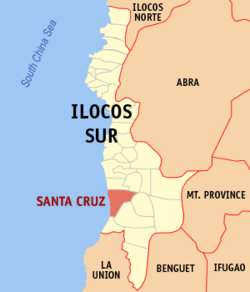Santa Cruz, Ilocos Sur
| Santa Cruz | |||
|---|---|---|---|
| Municipality | |||

Santa Cruz Municipal Hall
|
|||
|
|||
 Map of Ilocos Sur showing the location of Santa Cruz. |
|||
| Location within the Philippines | |||
| Coordinates: 17°05′N 120°27′E / 17.08°N 120.45°ECoordinates: 17°05′N 120°27′E / 17.08°N 120.45°E | |||
| Country | Philippines | ||
| Region | Ilocos (Region I) | ||
| Province | Ilocos Sur | ||
| District | 2nd District | ||
| Barangays | 49 | ||
| Government | |||
| • Mayor | Teresita Corpus Valle | ||
| Area | |||
| • Total | 88.78 km2 (34.28 sq mi) | ||
| Population (2015 census) | |||
| • Total | 39,868 | ||
| • Density | 450/km2 (1,200/sq mi) | ||
| Time zone | PST (UTC+8) | ||
| ZIP code | 2713 | ||
| IDD : area code | +63 (0)77 | ||
| Income class | 1st class | ||
| Website | stacruz-is |
||
Santa Cruz (/ˈsæntə ˈkruːz/, Spanish: Holy Cross) is a first class municipality in the province of Ilocos Sur, Philippines. According to the 2015 census, it has a population of 39,868 people.
Santa Cruz is politically subdivided into 49 barangays.
The place now known as Santa Cruz was the site where Captain Juan de Salcedo landed to get provisions, especially water, on his way to pacify the North. As soon as they came ashore, his men went immediately to the top of the highest sand dune and planted a big wooden cross to signify the place has been conquered by the white men (like what they did later in Santa Catalina). This cross is visible to mariners passing by, often describing the place as "Santa Cruz." The cross may have vanished, but the name Santa Cruz stuck, especially with natives who became Christians.
In the 2015 census, the population of Santa Cruz, Ilocos Sur, was 39,868 people, with a density of 450 inhabitants per square kilometre or 1,200 inhabitants per square mile.
...
Wikipedia



